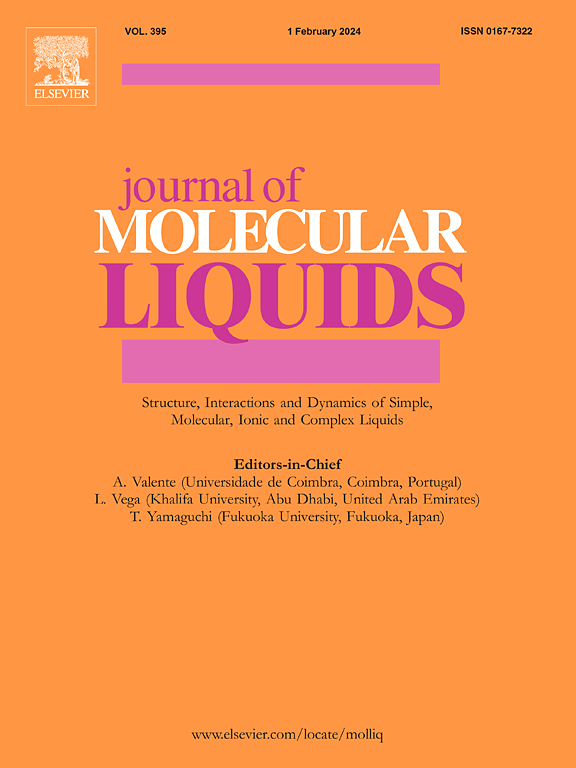Synergistic enhancing low-rank coal flotation mechanisms using nanocarrier collector through pore sealing and surface hydrophobicity
IF 5.3
2区 化学
Q2 CHEMISTRY, PHYSICAL
引用次数: 0
Abstract
Low-rank coal (LRC) is difficult to float using conventional oily collectors due to the rich oxygen-containing functional groups and abundant pores on its surface. In this study, an effective nanocarrier collector containing both nanoemulsion and nanoparticle with droplet size of 10–70 nm was developed, through diesel-beeswax mixture and AEO-7 using low-energy shearing and rapid cooling emulsification to enhance the LRC flotation. The surface morphology and elemental compositions of LRC were firstly characterized using SEM and EDS, identifying its difficult-to-float mechanisms. Then, the macroscopic appearance and microscopic size distribution of nanocarriers, and flotation tests were conducted to determine the optimum formula of nanocarrier collector for LRC. The results indicated that the recovery rate of combustibles was first increased and then decreased, by increasing the mass ratio of beeswax to diesel. When the mass ratio of diesel, beeswax, and AEO-7 was 2:3:5, the recovery rate of combustibles could be achieved to 92.98 %. Finally, the BET specific surface area, water adsorption, contact angle and wrap angle experiments were conducted to clarifying the synergistic enhancing LRC flotation mechanisms of nanocarriers collector. The nanocarriers could permeate into and seal the LRC surface pores, thereby reducing the both surface pore volumes and specific surface area. In addition, the mixtures of diesel and beeswax synergistically improved the surface hydrophobicity. Consequently, this research provides new insight into the development of effective collectors for LRC flotation.
利用纳米载体捕收剂通过孔隙密封和表面疏水性协同增强低阶煤浮选机理
由于低阶煤(LRC)表面含有丰富的含氧官能团和大量孔隙,因此很难使用传统的油性收集器进行浮选。本研究利用低能剪切和快速冷却乳化技术,通过柴油-蜜蜡混合物和 AEO-7 开发了一种有效的纳米载体捕收剂,其中既有纳米乳液,也有液滴粒径为 10-70 nm 的纳米颗粒,从而提高了低阶煤的浮选效果。首先利用 SEM 和 EDS 对 LRC 的表面形貌和元素组成进行了表征,确定了其难浮机理。然后,对纳米载体的宏观外观和微观粒度分布进行了分析,并进行了浮选试验,以确定沥青还原渣纳米载体捕收剂的最佳配方。结果表明,随着蜂蜡与柴油质量比的增加,可燃物的回收率先升后降。当柴油、蜂蜡和 AEO-7 的质量比为 2:3:5 时,可燃物回收率可达 92.98%。最后,通过 BET 比表面积、水吸附、接触角和包角实验,阐明了纳米载体捕集剂协同增强 LRC 浮选的机理。纳米载体可渗透并封闭 LRC 表面孔隙,从而减少表面孔隙体积和比表面积。此外,柴油和蜂蜡的混合物还能协同改善表面疏水性。因此,这项研究为开发用于 LRC 浮选的有效捕收剂提供了新的思路。
本文章由计算机程序翻译,如有差异,请以英文原文为准。
求助全文
约1分钟内获得全文
求助全文
来源期刊

Journal of Molecular Liquids
化学-物理:原子、分子和化学物理
CiteScore
10.30
自引率
16.70%
发文量
2597
审稿时长
78 days
期刊介绍:
The journal includes papers in the following areas:
– Simple organic liquids and mixtures
– Ionic liquids
– Surfactant solutions (including micelles and vesicles) and liquid interfaces
– Colloidal solutions and nanoparticles
– Thermotropic and lyotropic liquid crystals
– Ferrofluids
– Water, aqueous solutions and other hydrogen-bonded liquids
– Lubricants, polymer solutions and melts
– Molten metals and salts
– Phase transitions and critical phenomena in liquids and confined fluids
– Self assembly in complex liquids.– Biomolecules in solution
The emphasis is on the molecular (or microscopic) understanding of particular liquids or liquid systems, especially concerning structure, dynamics and intermolecular forces. The experimental techniques used may include:
– Conventional spectroscopy (mid-IR and far-IR, Raman, NMR, etc.)
– Non-linear optics and time resolved spectroscopy (psec, fsec, asec, ISRS, etc.)
– Light scattering (Rayleigh, Brillouin, PCS, etc.)
– Dielectric relaxation
– X-ray and neutron scattering and diffraction.
Experimental studies, computer simulations (MD or MC) and analytical theory will be considered for publication; papers just reporting experimental results that do not contribute to the understanding of the fundamentals of molecular and ionic liquids will not be accepted. Only papers of a non-routine nature and advancing the field will be considered for publication.
 求助内容:
求助内容: 应助结果提醒方式:
应助结果提醒方式:


